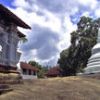ලංකාතිලක විහාරය නුවර
The Lankatilaka temple history runs back to the Gampola Kingdom era. King Buwanekabahu IV has built this temple in 1344 AD. The King's Chief Ministers Senalankadhikara was entrusted to carryout the construction work of this temple. The South Indian architect Sthapati Rayar has designed this with a blend of Sinhalese architecture of Polonnaruwa period and of Dravidian and Indo Chinese style is the opinion of late Professor Paranavitana. Considered to be a Gedige type of Polonnaruwa architecture, this temple which was of four stories earlier is constructed on the uneven surface of the rock with a granite based foundation. The plan of the temple protrudes to the four sides like of a cross. What is seen today is the Ground Floor and part of the First Floor of the earlier temple though the temple seems to have three stories. This temple is an example for the Buddha and God worship prevailed during Gampola era. Gods Vishnu, Saman , Vibhishana, Ganapathi , Skandhakumara and Kumara Bandara had been worshipped here.
The Lankatilaka temple can be approached from two directions. Here it is through the Sanghawasa which is situated at the bottom of the rock. There are Rice storage bins called 'Atuwa' at the Vihara premises. The Steps leading up to the temple starts from here.
There are two separate flights of steps cut into the living rock of Panhangala. One runs back to the time of the Gampola Kingdom of the 14th century and the other was constructed in around AD 1913. A beautiful view of the surrounding landscape could be seen from the stone stairway.
The rock inscriptions found in the temple is cut into the solid rock covering a large area. Both Sinhala and Tamil inscriptioned sections could be found here describing the facilities provided to the Temple and land gifted by the kings.
The vihara is entirely located on the rock surface and according to the Lankatilaka Copper plaque, the temple was built as a four storied building reaching a height of eighty feet. The stone foundation was built on to the uneven rock surface and brick was made used to build the structure on that. The thick outer walls are well designed with arches and sculptures which makes the Lankatilaka temple a unique architectural features of the fourteenth century design concepts which includes Gandharva and Gaja Lakshmi arts also.
Listing Details
Address
පිලිමතලාව, නුවර, ශ්රී ලංකාව












